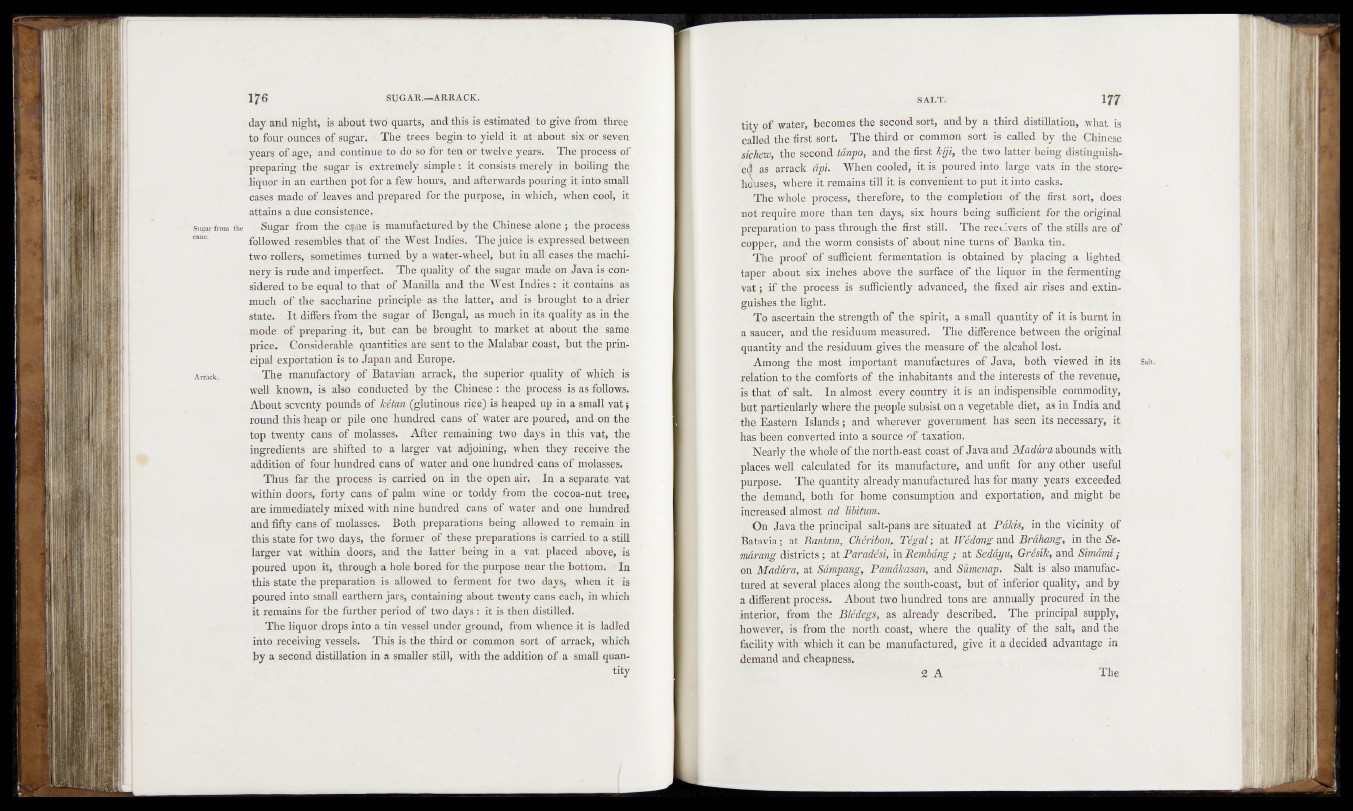
- day and night, is-about two' quarts', and this is estimated to give from three
to four ounces, of sugar. The trees Ibegin-to yield' it- at- about six- o r seven
years of age;':and continue.to do so,Tor ten or twelve years. ■ The process of
■preparing the-sugar is-'extremely simpler it consists-merely in boiling the
liquor in an earthen pot for a few hours, and afterwards pouring, it Into small
cases made of leaves and prepared' for the purpose, -in which, when cool, it
attains ardue.consistence^: ■
sugar from the 5 Sugar from c.the c%ne is manufactured, by,the Chinese alone ; the process
followed resembles that oftthe WestTndies. fTh.e-juice-is,expressed-between
two rollers, 'sQmétimes, turned by a water-wheel^ but in all-casesThe,^machinery
is rude.and imperfect. • The quality of the sugar made-on Java is considered
to be equal to that-.of Manilla and the West Indies :; itfcontains as
much of, the saccharine principle-as the latter, and'is brought to a drier
state. It differs, from the sugar of Bengal, as much in; its quality as in the
mode of preparing it, but- can;=be brought to Jmarket' at yabóut ' the' safhe
price. Considérable, quantities are sent to the -Malabar coast, -but the principal
exportation is to Japan and Europe.
Arracb. The manufactory of Batavian arrack, the superior quality of which is
well known, is also conducted .by the- Chinese.: 'thé process is as follows.
About seventy pounds of kétent (glutinous rice) is heaped Up-in a small vat;
round this heap or: pile- one' hundred cans’ of water are^pourëd, and on the
top twenty cans of molasses. After remaining two day&rin this - vat; th.e
ingredients are shifted to a larger .vat adjoining, whe'n«ftrey> receiye-fthe
addition of four hundred cans of water and one hundred cans »of molasses.
Thus far.the process .is carried on in the ,open ain- , In,a separate vat
within doors, forty, cans of palm wine -.or toddy from’rfhe, cocoa-nut- ftree,-
are immediately mixed with nine hundred cans icrf -water and- one rhundrêd
and -fifty cans of molasses. Both. preparations being, allowed ;to remain» in
this, state for two days, the former, of these preparations is-'carried-to a' still
larger vat ..within ;doors, • and the latter-being in a Vat placed above, -is
poured upon it, tthrough a hole-bored-for the purpose near the bottom. ‘In
this state the preparation is allowed to »ferment for-two days, -.whep dt-f'is
poured ipto small earthern jars, containing about twenty cans èafch, in which
it remains for the further period of two days: it is then distilled. :
The liquor drops into a tin vessel' under ground, from whence it is ladled
into receiving vessels. This is the third or common sort of arrack, which
by a second distillation in a smaller still, with the addition of a small quantity
tity of .water, becomes the second sort, and by a third distillation, ,what is
called tb-e .first^ort. The third or r common sort--is-called by the Chinese
szch&w, the.second tempo, and the-first.hiji, the.two latter being distinguished
as arrack dpi. cooled,,it|is,,poured into. larger vats, ip the store-'
houses, where it remaina»lj.ljjt,is convenient to put it in|o qasks. ;
. ' The whMe process, therefore, to the completion qf. the first- port, .does
not-require,,mor,e than ten days, sixhoifrs. being sufficient;-:for the original
preparation, to pass through-the, first still. The receivers of the .stills are Of
eppper, and thp w(orm consists,oj^aMiit .nine turns of, Banka;tip.,:
, The proof of sufficient fermentation is obtained by placing a lighted;
taper about six inches aboye the .surface of the Jiquor in the fermenting
vat; if the pfocess is sufficiently advanced, the fixed air rises and extinguishes
theligbtiwto
To ascertain the strength aft the: spirit, a squall .quantity of it is burnt in
a saucer, and the residuum measured. The difference between the original
quantity and the residuum gives BEe measure of the alcahol lost. ,
Among the most important manufactures, of Java, i, both (viewed jin its
.relation.to the comfofts of tlie inhabitants, jand the interests of the revenge,r
is that of salt. In almost ^dyery country it is an indisp.ensible commodity,
but particularly where fhe people subsist on'a;vegetable diet,^ as in India and
the-Eastern tIslands; and yrherever- government has seen, its necessary, it
has-oeen-converted into a source pf-taxation,
* ‘ Nfi^y' theVwhqje of the north-east coast dfiJava and'Madfara abqunds with
places well calculated for its manufacture, and unfit .-.faq, any. other useful
purpose. The quantity already manufactured has for many years exceeded
the" demand, both for ,'home consumption and exportation, and might be
increased almost' ad Ubitum.
/ On:Java the principal salt-pans ai;e situated at Fains, i%the vicinity of
Batavia; at Bantam, Cheribon^ Tegal; at Wedmg, and Brdhang, in the Se-
mdrang districts; at Paradesi, in Rembdng ; at Seddyu,,Gresik, and Simdmi ;
on Madiera, at Sdmpang, Pamdkasan, and Siimenap. Salt is also manufactured
at several places along the south-eqast, but ;o£* inferior quality, and by
a different process. About two hundred, tons are annually procured in the
interior, from the, BUdegs^as already described. . The principal supply,
howeVeliiis from the north coast,a where the quality of tpe; salt, and the,,
facility with which it can be manufactured, give it a decided advantage in.
demand and cheapness.
2 A The